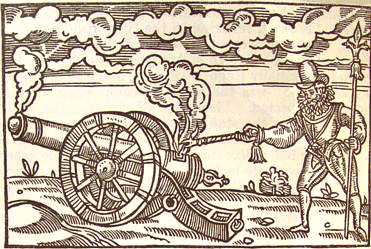The technology of warfare
From cavalry* to the longbow to cannon: the escalation of technology in war was well under way by the time Shakespeare was writing.
Edward I introduced the Welsh longbow, which was used to devastating effect by Edward III and his son the Black Prince during the early phases of the Hundred Years War, and by Henry V at the Battle of Agincourt* (1415).
"Villainous saltpetre"
Hotspur makes his excuse to Henry IV for not yielding his prisoners of war, by telling a story about the courtier who brought the demand. The effeminate courtier (so Hotspur claims) remarked
. . . that it was great pity, so it was,
This villainous saltpetre should be digged
Out of the bowels of the harmless earth,
Which many a good tall fellow had destroyed
So cowardly, and but for these vile guns,
He would himself have been a soldier.
(Henry IV, Part One, 1.3.58-63)
Saltpetre (potassium nitrate) is one of the major ingredients of gunpowder. Click here to read about the revolutionizing effect gunpowder and cannon* had on warfare.
Footnotes
-
Cavalry
During the early Crusades heavy cavalry was the principal military force in Western Europe. Tactics involved a powerful shock attack of charging horses that overwhelmed an opposing army. Shock cavalry was especially effective against concentrated light forces, as was demonstrated in the Norman conquest of England in 1066. Tournaments began as a method of training for combat in highly coordinated fighting units, practicing such manoevres as the feigned cavalry retreat.
-
"We happy few . . ."
French defeats resulted from their continued reliance on shock cavalry and a tactical error of organizing the three "battles" (divisions -- see below) of their armies behind each other; thus at Agincourt the weight of their rear divisions piled up on those cut down by English arrows in the front lines, preventing an organized retreat and counterattack. The English carried the day despite being vastly outnumbered and weakened from long campaigning.
"Battles"
Hotspur uses the same term when he asks about the size of Henry's army before the battle of Shrewsbury: "What may the King's whole battle reach unto?"
(Henry IV, Part One, 4.1.128).
-
Cannon take over
The tide of war turned against the English largely due to Charles VII's creation of the first standing army in Western Europe since Roman times, and his effective use of siege cannons to reduce English strongholds.
The introduction of gunpowder revolutionized warfare. Crude siege artillery, used as early as 1326, developed by the mid-15th century into massive cannons able to hurl stones weighing 350 kilograms. Such cannons were instrumental in the Muslim conquest of Constantinople (1453), the mightiest citadel of Western Christendom in the Middle Ages. The fall of Constantinople was such a shock to the Christian world that it is often used as a reference point marking the end of the Middle Ages.
